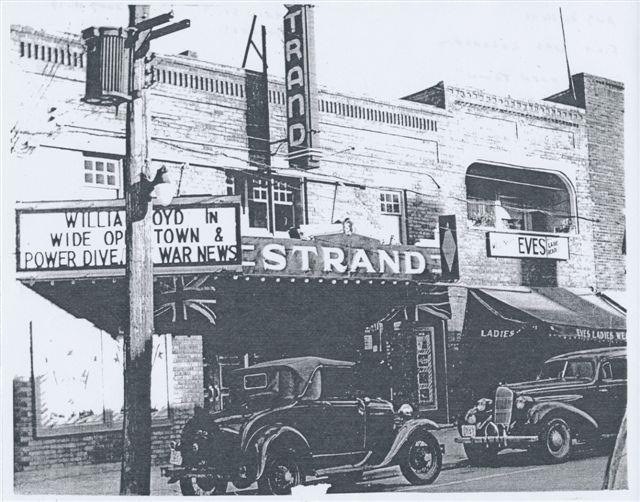The cinema — known as moving pictures in my Grandma’s era — has long been a major source of entertainment around the world. This weekend, we will explore the history of the movie theatre in Newmarket and hopefully bring back some memories for many of you.
While we know that the moving picture has been around since the late 1800s, the first reference I could find to a public showing of movies here in Newmarket is in the October 30, 1896 edition of The Era, in which they report “a demonstration (three showings) held in the Town Hall on Botsford Street.
Thomas A. Edison’s new invention called the animatography or kinetoscope, which projected life-size moving pictures on a screen. There was, of course, no sound until much later.
While I am told several private parties would take place in the early 1900s at people’s homes where moving pictures would be shown, it was not until 1909 that the Colonial Theatre, located in the Temperance Hall on Millard, added moving pictures and live performances to its entertainment offerings to go along with its community and political gatherings.
The building was a timber frame structure 33 feet by 42 feet originally built as a church in 1856 and moved to its current location in 1873. It was a neo-classical design with a centre entrance in the vestibule with a gallery above that would accommodate 20 people at a time. The main floor area seated about 80 people on wooden benches. The Temperance Hall was acquired by the Masons in 1957 when it was renovated and became the Tuscan Lodge.
In late 1909, at 224 Main St. (west side), a commercial store was converted to a movie house. It was within a two-storey commercial block and it had no architectural features except for the ticket office at the entrance. It operated under the banner of the Colonial Theatre until it was sold in April 1912 to the Canadian Amusement Company. It was soon after that Arthur Winn, an Aurora man who owned and operated a movie theatre there, purchased the old Colonial Theatre.
Winn changed the name of the Colonial Theatre to the Strand Theatre and it continued under that name from 1912 to 1923, when it closed its doors when the new Palace Theatre was built on the east side of the street. The Strand Theatre was then converted to a Chinese restaurant in March 1924 and continued there until 1987.
In January 1916, a store at 198 Main St. (west side) was altered to become a movie house. At this time, the Strand was still operating further to the south on Main. This new movie theatre was contained on the ground floor of a four-storey building between a bank and a clothing store. It was called the Patricia Theatre, owned by Herbert Kinley, and it only operated for a short time, until June of 1917 when it closed.
The location then became a barber shop and a pool room and later a National Trust bank when I was young. Kinsley then formed a partnership with Winn of the Strand Theatre and they operated both the Strand Theatre in Newmarket and the Royal Theatre in Aurora. Later, Kinley left the partnership, with Winn carrying on.
In 1923, a new building was erected at 255 Main St. on the east side on a vacant lot owned by E. H. Adams, who also owned the barbershop and pool hall at the former location of the Patricia Theatre.
In June 1923, the new theatre was purchased by Winn, who had operated the Palace Theatre. He died in October 1937 and the theatre was purchased by the Premier Operating Corporation. The Palace Theatre continued until 1950 when the building was sold and converted to a clothing store.
We now get to my era. A new theatre was built on the west side of Main opposite the former Palace Theatre which had closed at the same time that the new Roxy Theatre opened.
The Odeon theatre chain acquired the theatre in the early 1950s and the name was changed to the Odeon Theatre about 1964. I always called it the Roxy because that is what my parents called it. It continued until January 1985, and the building was converted for commercial purposes. It is now the Brad Jones Karate-Do and Fitness Centre.
The move had already begun toward larger, multi-screen movie theatres. Two new theatres opened in town, one on Charles Street and one on Millard, in the new Glenway development. This brought the total to three movie theatres in Newmarket in 1983 and 12 movies running every night — we had hit the big-time.
The Roxy would close in 1984, leaving just two theatres in town. On Charles Street, the Film Factory 6 had opened in 1983 and was owned by June Tarrant and family. It was a small, industrial-looking building on the west side, which became very popular. On Millard there was another multi-screen complex, Famous Players, which opened in January 1984 and offered five mini-theatres next to a Sloppy Joe’s restaurant.
Alas, with the arrival of Silver City Newmarket Cinemas and XSCAPE Entertainment Centre in late 2000, on Yonge Street at Green Lane, all of the smaller movie theatres were closed. The quaint movie house of my childhood had been pushed out and a huge entertainment complex had taken its place.
I still love to go to the movies, but the excitement of a movie, a newsreel, perhaps a couple of cartoons and treats for a little more than a dollar still holds a warm spot in my heart. How about you?
I have included some ads for movies over the years that should bring back some of those memories.
Sources: The Newmarket Era – 1896 thru 2010; The History of Newmarket by Ethel Trewhella; The Town Crier.
